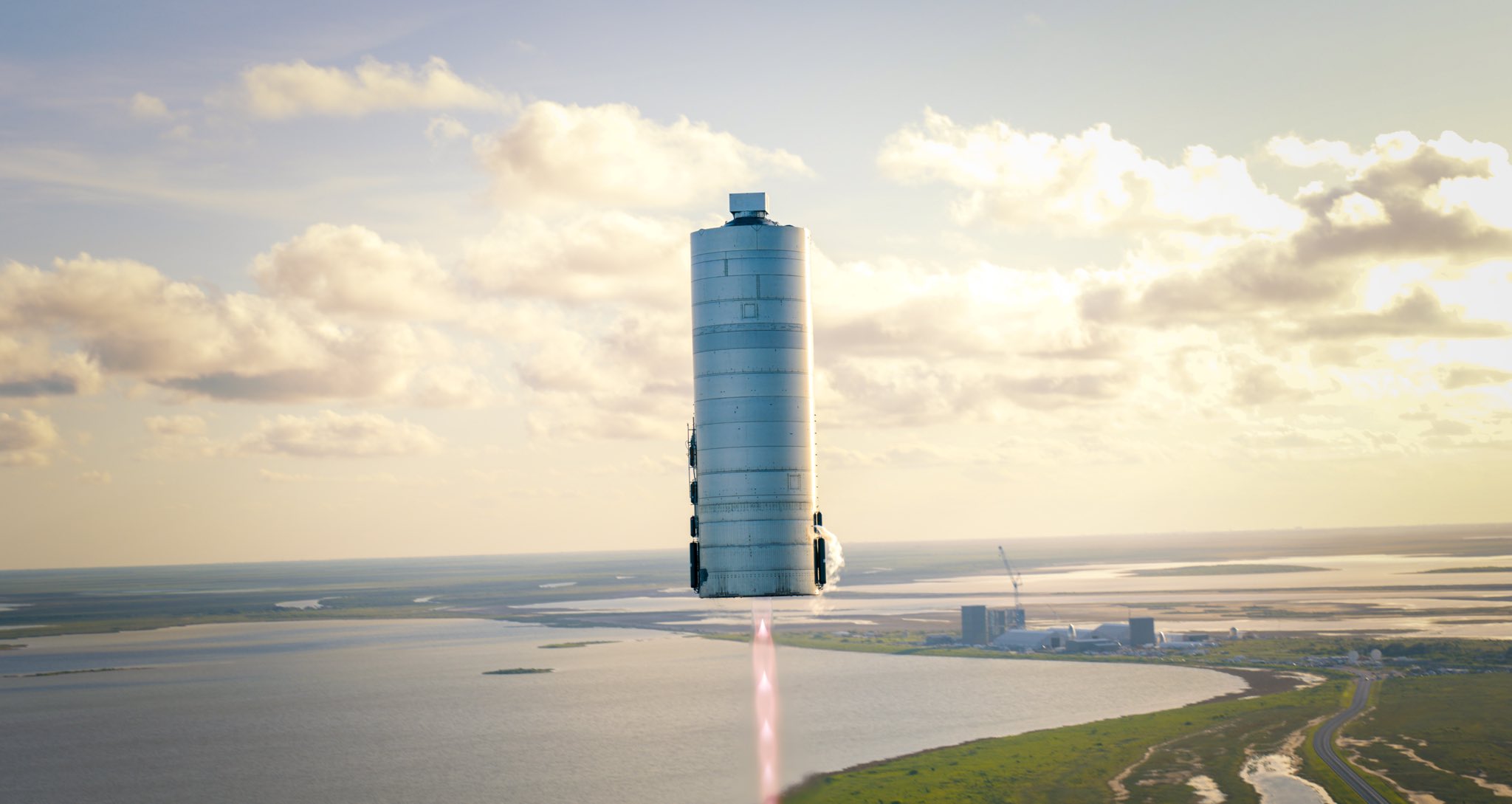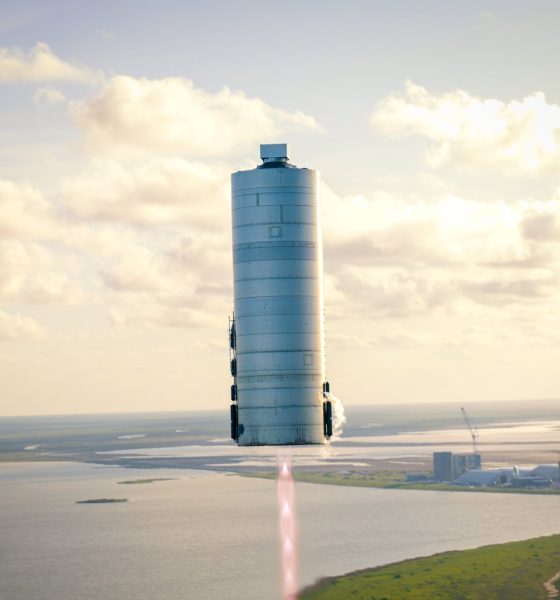

News
SpaceX partners with US military to study using rockets for worldwide cargo delivery
SpaceX has partnered with the U.S. Military to study joint cargo transportation efforts using the private spaceflight company’s Starship rockets. The cooperative research and development agreement (CRADA), also featuring Exploration Architecture Corporation (XArc), is a voluntary effort wherein the participants donate time and resources to help develop “use cases” involving their technology. If successfully completed and the findings implemented, SpaceX’s rockets would deliver emergency military cargo anywhere in the world in under an hour.
“As industry advances to overcome these challenges and decrease costs, a space transportation capability to put a crucial cargo quickly on target at considerable distances makes it an attractive alternative,” remarked Vice Admiral Dee Mewbourne, the U.S. Transportation Command (TRANSCOM) Deputy Commander, as reported by SpaceNews. “I had no sense for how fast SpaceX was moving, but I’ve received their update and I can tell you they are moving very rapidly in this area,” explained General Stephen Lyons, Commander of TRANSCOM. “Think about moving the equivalent of a C-17 payload anywhere on the globe in less than an hour.”
The joint study was announced at the National Defense Transportation Association’s virtual conference last week.
At the beginning of the COVID-19 pandemic, the US Federal Emergency Management Agency (FEMA) launched “Project Airbridge,” partnering with commercial air cargo companies to bring millions of medical supplies into the country. The effort accelerated supply transport from the conventional 30-40 days shipping time frame to a two-day process via airplanes, and a total of around 250 flights were completed before the project was phased out in June. The recent US Military-SpaceX study would likely include case study solutions for scenarios like Project Airbridge, possibly reducing both the time and flights required to transport the tons of supplies that were needed.
The technology involved in the US Military-SpaceX CRADA was first discussed in detail by SpaceX CEO Elon Musk in 2017 at the International Astronautical Congress. A video concept showed passengers in New York City ferrying to a floating platform where they would board a Starship-class rocket for a 40-minute trip to Shanghai. “So, most of what people consider to be long distance trips would be completed in less than half an hour,” Musk said in the presentation. COO and President Gwynne Shotwell gave a Ted Talk in 2018 further discussing the technology and its implications for future civilian travel.
Using Starship’s eventual point-to-point transportation capabilities in a military capacity were teased at the Association of the U.S. Army’s annual conference 2019. During the event, Shotwell appeared on a panel discussing the service’s efforts to modernize forces by bringing more innovation into their procurement process. “We’re talking to the Army about Starlink and Starship,” the COO revealed in comments to SpaceNews. SpaceX had previously revealed it had discussed the technology with the US Air Force in 2018. This most recent study announcement seems to formalize the parties’ interest in working with one another.

News
Tesla FSD fleet is nearing 7 billion total miles, including 2.5 billion city miles
As can be seen on Tesla’s official FSD webpage, vehicles equipped with the system have now navigated over 6.99 billion miles.

Tesla’s Full Self-Driving (Supervised) fleet is closing in on almost 7 billion total miles driven, as per data posted by the company on its official FSD webpage.
These figures hint at the massive scale of data fueling Tesla’s rapid FSD improvements, which have been quite notable as of late.
FSD mileage milestones
As can be seen on Tesla’s official FSD webpage, vehicles equipped with the system have now navigated over 6.99 billion miles. Tesla owner and avid FSD tester Whole Mars Catalog also shared a screenshot indicating that from the nearly 7 billion miles traveled by the FSD fleet, more than 2.5 billion miles were driven inside cities.
City miles are particularly valuable for complex urban scenarios like unprotected turns, pedestrian interactions, and traffic lights. This is also the difference-maker for FSD, as only complex solutions, such as Waymo’s self-driving taxis, operate similarly on inner-city streets. And even then, incidents such as the San Francisco blackouts have proven challenging for sensor-rich vehicles like Waymos.
Tesla’s data edge
Tesla has a number of advantages in the autonomous vehicle sector, one of which is the size of its fleet and the number of vehicles training FSD on real-world roads. Tesla’s nearly 7 billion FSD miles then allow the company to roll out updates that make its vehicles behave like they are being driven by experienced drivers, even if they are operating on their own.
So notable are Tesla’s improvements to FSD that NVIDIA Director of Robotics Jim Fan, after experiencing FSD v14, noted that the system is the first AI that passes what he described as a “Physical Turing Test.”
“Despite knowing exactly how robot learning works, I still find it magical watching the steering wheel turn by itself. First it feels surreal, next it becomes routine. Then, like the smartphone, taking it away actively hurts. This is how humanity gets rewired and glued to god-like technologies,” Fan wrote in a post on X.
News
Tesla starts showing how FSD will change lives in Europe
Local officials tested the system on narrow country roads and were impressed by FSD’s smooth, human-like driving, with some calling the service a game-changer for everyday life in areas that are far from urban centers.

Tesla has launched Europe’s first public shuttle service using Full Self-Driving (Supervised) in the rural Eifelkreis Bitburg-Prüm region of Germany, demonstrating how the technology can restore independence and mobility for people who struggle with limited transport options.
Local officials tested the system on narrow country roads and were impressed by FSD’s smooth, human-like driving, with some calling the service a game-changer for everyday life in areas that are far from urban centers.
Officials see real impact on rural residents
Arzfeld Mayor Johannes Kuhl and District Administrator Andreas Kruppert personally tested the Tesla shuttle service. This allowed them to see just how well FSD navigated winding lanes and rural roads confidently. Kruppert said, “Autonomous driving sounds like science fiction to many, but we simply see here that it works totally well in rural regions too.” Kuhl, for his part, also noted that FSD “feels like a very experienced driver.”
The pilot complements the area’s “Citizen Bus” program, which provides on-demand rides for elderly residents who can no longer drive themselves. Tesla Europe shared a video of a demonstration of the service, highlighting how FSD gives people their freedom back, even in places where public transport is not as prevalent.
What the Ministry for Economic Affairs and Transport says
Rhineland-Palatinate’s Minister Daniela Schmitt supported the project, praising the collaboration that made this “first of its kind in Europe” possible. As per the ministry, the rural rollout for the service shows FSD’s potential beyond major cities, and it delivers tangible benefits like grocery runs, doctor visits, and social connections for isolated residents.
“Reliable and flexible mobility is especially vital in rural areas. With the launch of a shuttle service using self-driving vehicles (FSD supervised) by Tesla in the Eifelkreis Bitburg-Prüm, an innovative pilot project is now getting underway that complements local community bus services. It is the first project of its kind in Europe.
“The result is a real gain for rural mobility: greater accessibility, more flexibility and tangible benefits for everyday life. A strong signal for innovation, cooperation and future-oriented mobility beyond urban centers,” the ministry wrote in a LinkedIn post.
News
Tesla China quietly posts Robotaxi-related job listing
Tesla China is currently seeking a Low Voltage Electrical Engineer to work on circuit board design for the company’s autonomous vehicles.

Tesla has posted a new job listing in Shanghai explicitly tied to its Robotaxi program, fueling speculation that the company is preparing to launch its dedicated autonomous ride-hailing service in China.
As noted in the listing, Tesla China is currently seeking a Low Voltage Electrical Engineer to work on circuit board design for the company’s autonomous vehicles.
Robotaxi-specific role
The listing, which was shared on social media platform X by industry watcher @tslaming, suggested that Tesla China is looking to fill the role urgently. The job listing itself specifically mentions that the person hired for the role will be working on the Low Voltage Hardware team, which would design the circuit boards that would serve as the nervous system of the Robotaxi.
Key tasks for the role, as indicated in the job listing, include collaboration with PCB layout, firmware, mechanical, program management, and validation teams, among other responsibilities. The role is based in Shanghai.
China Robotaxi launch
China represents a massive potential market for robotaxis, with its dense urban centers and supportive policies in select cities. Tesla has limited permission to roll out FSD in the country, though despite this, its vehicles have been hailed as among the best in the market when it comes to autonomous features. So far, at least, it appears that China supports Tesla’s FSD and Robotaxi rollout.
This was hinted at in November, when Tesla brought the Cybercab to the 8th China International Import Expo (CIIE) in Shanghai, marking the first time that the autonomous two-seater was brought to the Asia-Pacific region. The vehicle, despite not having a release date in China, received a significant amount of interest among the event’s attendees.








